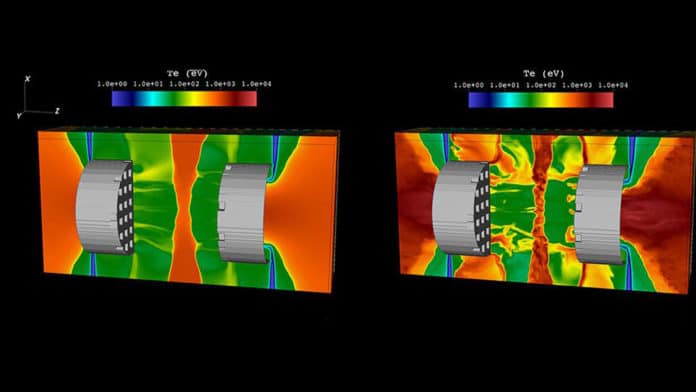Galaxy clusters are filled with hot, diffuse X-ray emitting plasma with a stochastically tangled magnetic field. This plasma exists in a turbulent state. Most of the observed galaxy clusters appear much hotter than expected. This is a difficult riddle that astronomers have been facing.
Using the world’s most extensive laser system- the National Ignition Facility (NIF), a collaboration of international scientists has unraveled the inner workings of heat conduction in galaxy clusters. The team was led by the University of Oxford, Rochester, and the University of Chicago.
Scientists used the laser system to create a replica of the plasma conditions expected to occur in the clusters of galaxies. They used laser beams to vaporize plastic foils. This generated a turbulent and magnetized plasma in the experiments at NIF.
Co-author Professor Alexander Schekochihin, Department of Physics at the University of Oxford, says that “how energy is injected into the plasma that fills galaxy clusters by the violently active galaxies at their centers, how it is then spread around and heats the entire enormous system, producing the X-ray glow that observatories like Chandra X-ray Observatory pick up—these are fundamental questions about the largest building blocks of our Universe. Both observations and the logic of our theoretical models suggest that heat conduction in these plasmas is strongly suppressed compared to naïve expectations. Several schemes for such suppression have been theorized about and simulated numerically, but very tentatively.”
“Here suddenly we have it in a real laboratory plasma—and so experiment now has a chance to leapfrog theory in helping sort out the basic properties of an astrophysical plasma, an exciting prospect.”
The experiments conducted at the NIF could potentially bring the powerful dynamics of the Universe to the laboratory. The uniqueness of these NIF experiments is that electron collision in the plasma ends up following the tangled magnetic field lines. This phenomenon is believed to occur in galaxy clusters, gives rise to suppressed heat conduction.”
Scientists observed this effect in lab data. The measurements show pockets of hot plasma that persist in time, and heat cannot escape.
The principal investigator for the experiments, Professor Gianluca Gregori, Department of Physics at the University of Oxford, says that “this work is an important stepping stone to understanding the microscopic processes that occur in plasmas that are both magnetized and turbulent. The experimental findings are somewhat surprising as they demonstrate that energy is transported in ways that are very different from what we would have expected from simple theories.”
Professor Petros Tzeferacos, director of the Flash Center of Computational Science, said, “This is indeed an astonishing result. To model the NIF experiments, we brought to bear the full array of physics capabilities of FLASH, the multi-physics simulation code we developed. The FLASH simulations were key for untangling the physics at play in the turbulent, magnetized plasma, but the level of thermal transport suppression was beyond what we expected.”
Dr. James Steven Ross, the project’s liaison scientist at the LLNL, said, “These experiments provide insight into complex physics processes and also raise additional questions that we hope to answer in upcoming NIF Discovery Science experiments with an optimized target design and diagnostic configuration.”
Journal Reference:
- J. Meinecke et al., Strong suppression of heat conduction in a laboratory replica of galaxy-cluster turbulent plasmas, Science Advances (2022). DOI: 10.1126/sciadv.abj6799
